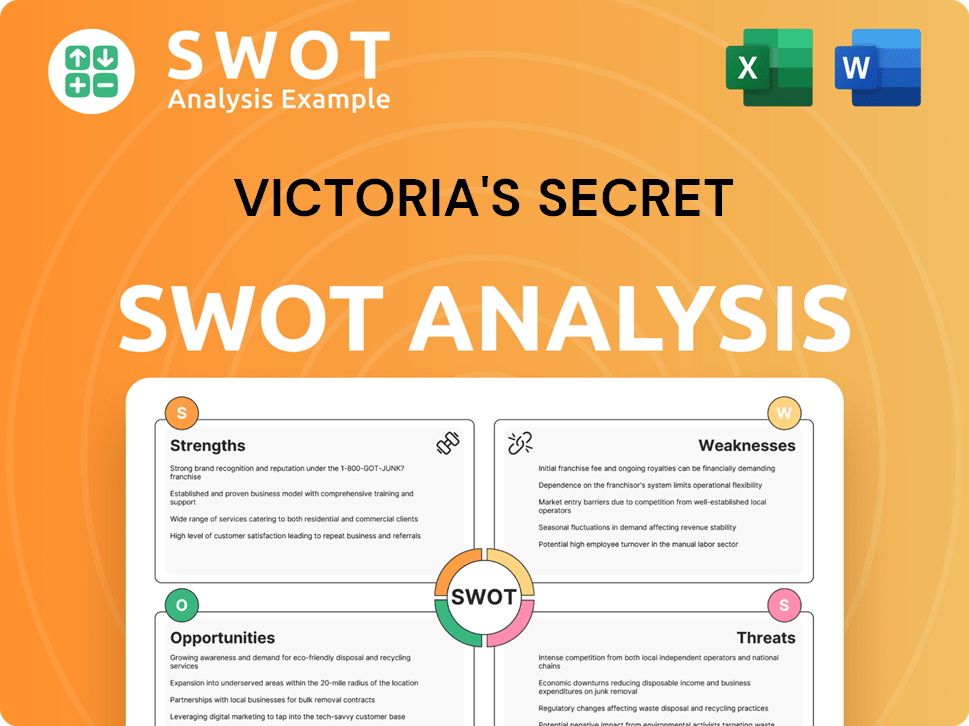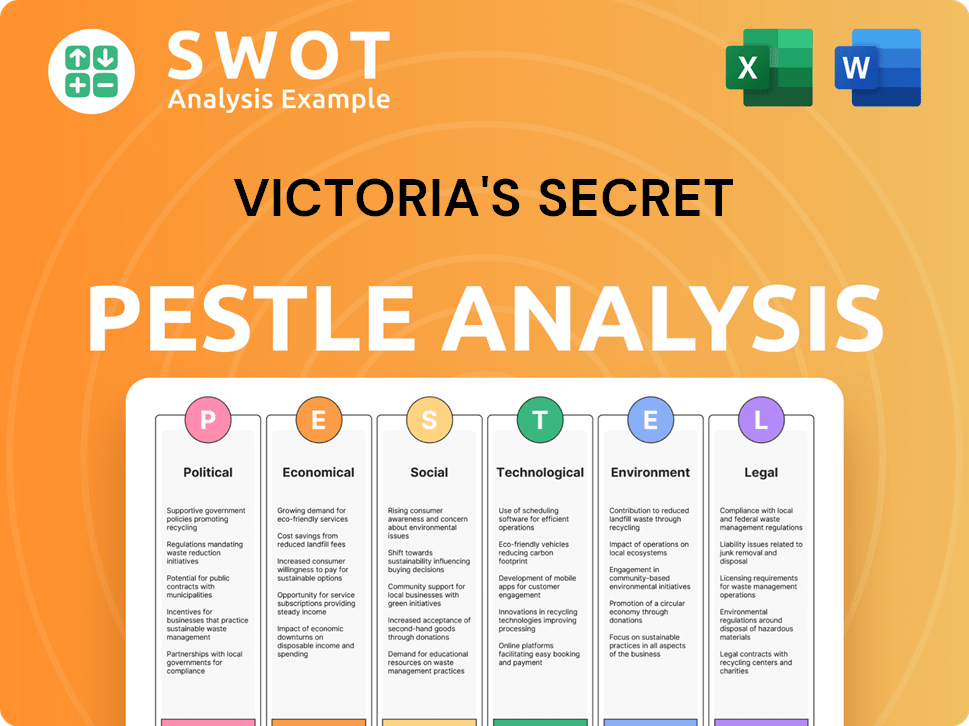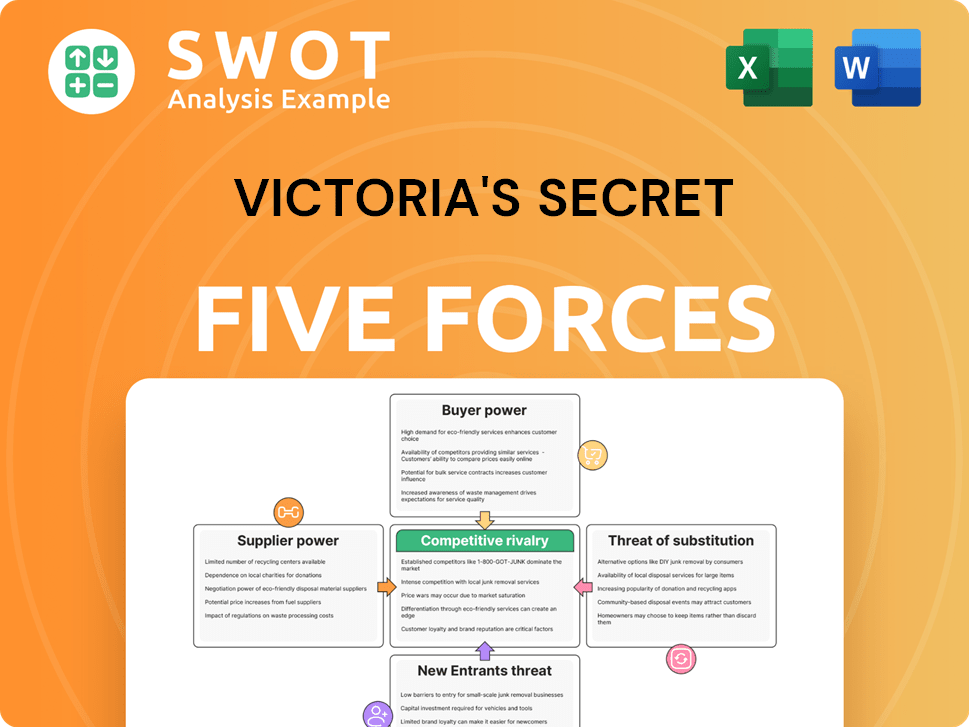Victoria's Secret Bundle
How is Victoria's Secret Navigating the Modern Retail Landscape?
Victoria's Secret, a powerhouse in the Victoria's Secret SWOT Analysis, is more than just a lingerie brand; it's a fashion retailer undergoing a significant transformation. The VS Company is adapting to evolving consumer preferences, particularly in embracing inclusivity and diversity, a critical shift in today's dynamic retail industry. With reported net sales figures and strategic initiatives, understanding how this iconic brand operates is key.

This exploration delves into the Victoria's Secret business model, examining its financial performance, including how the company makes money and its strategic initiatives. From its history and evolution to its current marketing strategy, product range, and online store operations, we'll uncover the inner workings of this retail giant. We'll also touch upon its customer service, brand image, and the store experience, alongside its competitors and any controversies it faces. This analysis provides actionable insights for investors and industry observers alike, offering a comprehensive view of Victoria's Secret's path forward.
What Are the Key Operations Driving Victoria's Secret’s Success?
The VS Company, a leading fashion retailer, focuses on creating value through its core brands: Victoria's Secret, PINK, and Adore Me. These brands offer a wide array of products, including bras, lingerie, sleepwear, and beauty items, catering to various customer segments. The company's mission is to be the premier intimate apparel retailer, emphasizing women's empowerment and diversity.
The Victoria's Secret business model revolves around a multichannel distribution network, encompassing both physical stores and e-commerce platforms. This strategy allows the company to reach a broad customer base and provide a seamless shopping experience. The company's commitment to superior fit, quality, and innovative product design further distinguishes its offerings in the retail industry.
Operational processes at Victoria's Secret involve product design, merchandising, production, logistics, and store operations. The company employs a dual supply chain strategy to balance speed for fashion-forward items and efficiency for basic products. This approach ensures that the company can adapt to changing consumer demands while maintaining cost-effectiveness.
Victoria's Secret has mapped its Tier 1 and Tier 2 supply chain for lingerie and apparel. A significant portion of its production facilities are located in Vietnam, Sri Lanka, Indonesia, the U.S., and China. The company's focus on ethical sourcing and supply chain transparency is a key aspect of its operational strategy.
The company directly purchases cotton from U.S. family farms, including women-owned and Black-owned farms. This initiative ensures farmers receive all proceeds and provides greater visibility into the cotton's origin. Regular audits are conducted to ensure compliance with the Supplier Code of Conduct.
As of February 1, 2025, Victoria's Secret & Co. operated 806 company-operated stores in North America. The company has a growing international presence with 575 stores across Asia, Europe, the Americas, the Middle East, and Africa. The company's store experience is designed to enhance customer engagement.
The company focuses on superior fit and quality in product innovation. Digital enhancements and in-store experiences are used to improve customer satisfaction. This approach helps to strengthen the Victoria's Secret brand image and customer loyalty.
Victoria's Secret delivers value through its diverse product range, multichannel distribution, and focus on customer experience. The company's commitment to quality and innovation, along with its efforts to promote diversity, helps to build a strong brand image and customer loyalty. To learn more about the company's financial performance, you can read this article about Victoria's Secret.
- Diverse product offerings, including bras, panties, and beauty products.
- Multichannel distribution network with physical stores and e-commerce.
- Emphasis on superior fit, quality, and innovative product design.
- Commitment to ethical sourcing and supply chain transparency.
Victoria's Secret SWOT Analysis
- Complete SWOT Breakdown
- Fully Customizable
- Editable in Excel & Word
- Professional Formatting
- Investor-Ready Format

How Does Victoria's Secret Make Money?
The VS Company generates revenue mainly through selling intimate apparel, beauty products, and accessories. Sales occur through stores, digital platforms, and franchise, license, and wholesale arrangements. This diversified approach allows the company to reach a wide customer base and adapt to changing consumer preferences.
For the fiscal year ending February 1, 2025, Victoria's Secret & Co. reported annual revenue of $6.23 billion, reflecting a 0.78% growth. This indicates a steady performance in a competitive market. In the fourth quarter of fiscal year 2024, the company's revenue was $2.11 billion, an increase of 1% compared to the prior year's fourth quarter.
The company's monetization strategies include its loyalty program, PINK Nation, which has 12.5 million active members and generated $750 million in direct program-related sales. Victoria's Secret continues to explore investment opportunities to drive sustainable growth and enhance its store capital program and technology investments. The company's forecast for fiscal year 2025 net sales is between $6.2 billion and $6.3 billion, a projected year-over-year increase of 0.3%.
Victoria's Secret earns its revenue through multiple channels. The primary sources include sales from company-operated stores, digital platforms, and international sales. Wholesale arrangements and licensing also contribute to the overall revenue.
The company utilizes a mix of sales channels. These include physical retail locations, an online store, and partnerships. This multi-channel approach helps the brand reach a broader audience and cater to different shopping preferences.
In fiscal year 2024, the company's net sales reached $6.176 billion. North America contributed $5.168 billion, while international sales brought in $1.008 billion. The fourth quarter of fiscal year 2024 saw revenues of $2.11 billion.
International sales are a significant part of the business. In 2024, international sales increased by 1%, with an 11% increase in the international channel. This growth is driven by sourcing sales, royalties, and wholesale arrangements.
The PINK Nation loyalty program is a key strategy. With 12.5 million active members, it generated $750 million in direct program-related sales. This program helps boost customer engagement and repeat purchases.
The company is focused on sustainable growth. It plans to invest in store capital programs and technology. The forecast for fiscal year 2025 net sales is between $6.2 billion and $6.3 billion, indicating a positive outlook.
The Marketing Strategy of Victoria's Secret plays a crucial role in its revenue generation. The brand's marketing efforts, including the PINK Nation loyalty program, contribute significantly to sales. The company's focus on digital platforms and international expansion further supports its monetization strategies. The company's performance reflects its ability to adapt and grow in the competitive retail industry.
Key financial data highlights the company's performance and strategies.
- Annual revenue for fiscal year 2024 was $6.176 billion.
- North American sales accounted for $5.168 billion.
- International sales reached $1.008 billion.
- The PINK Nation loyalty program generated $750 million in sales.
- The company is forecasting net sales between $6.2 billion and $6.3 billion for fiscal year 2025.
Victoria's Secret PESTLE Analysis
- Covers All 6 PESTLE Categories
- No Research Needed – Save Hours of Work
- Built by Experts, Trusted by Consultants
- Instant Download, Ready to Use
- 100% Editable, Fully Customizable

Which Strategic Decisions Have Shaped Victoria's Secret’s Business Model?
The VS Company has undergone significant transformations to adapt to evolving market dynamics and consumer preferences. A pivotal milestone was its separation into a standalone public company in 2021, which allowed for a focused transformation. Since then, the company has been committed to its 'Path to Potential' growth strategy, aiming to strengthen its core brands, expand high-potential categories, and evolve customer engagement.
This strategy includes a renewed emphasis on product innovation across bras, panties, lingerie, sleepwear, sport, swimwear, and beauty products, prioritizing superior fit and quality. Another key strategic move was the acquisition of Adore Me, a digital-first intimates brand, which has provided synergistic opportunities and fueled international growth. The company has also focused on refreshing its brand identity to be more inclusive and diverse, moving away from its previous singular image of beauty.
Despite these strategic shifts, the company has faced operational and market challenges. The retail environment in North America has been challenging, with a highly competitive promotional landscape. The company also experienced a cybersecurity incident in May 2025, which temporarily shut down its e-commerce platform and corporate systems, highlighting vulnerabilities in its digital infrastructure. This incident is expected to incur costs for system restoration and addressing vulnerabilities, potentially impacting Q2 2025 revenue by approximately $10 million.
The separation into a standalone public company in 2021 was a pivotal moment, enabling a focused transformation. This strategic move allowed Victoria's Secret to concentrate on its core brands and growth strategies.
The acquisition of Adore Me and the focus on brand inclusivity are key strategic initiatives. These moves aim to broaden the brand's appeal and enhance its digital presence. They also signal a shift in Victoria's Secret business model.
Strong brand recognition and an extensive distribution network are competitive advantages. The company leverages AI to personalize customer experiences and drive digital sales. The dual-brand strategy has shown signs of stabilizing comparable sales.
The North American retail environment presents challenges, including a competitive promotional landscape. The recent cybersecurity incident highlights vulnerabilities and potential financial impacts. These factors affect the retail industry.
Victoria's Secret maintains a strong brand presence, holding approximately 20% market share in the intimates market. Its extensive retail and online distribution network, along with its loyalty program, further solidify its position. The company is actively using artificial intelligence (AI) to improve customer experiences and boost digital sales.
- Strong brand recognition for both Victoria's Secret and PINK.
- Extensive retail and online distribution network.
- Loyalty program that enhances customer retention.
- Partnership with Google Cloud to leverage AI for personalized customer experiences.
- Dual-brand strategy showing signs of stabilizing sales, with a 5% rise in Q4 2024.
For a deeper dive into the competitive landscape, explore the Competitors Landscape of Victoria's Secret.
Victoria's Secret Business Model Canvas
- Complete 9-Block Business Model Canvas
- Effortlessly Communicate Your Business Strategy
- Investor-Ready BMC Format
- 100% Editable and Customizable
- Clear and Structured Layout

How Is Victoria's Secret Positioning Itself for Continued Success?
The VS Company maintains a significant position in the intimate apparel market. It holds roughly a 20% market share in the North American intimates market, solidifying its status as a leading lingerie brand. The company's global presence is substantial, with over 1,370 retail stores across nearly 70 countries.
However, the Victoria's Secret business model faces several challenges. The retail industry is highly competitive, and the company must navigate economic uncertainties and evolving consumer preferences. Operational risks and cybersecurity threats also pose significant hurdles.
The company is a leading fashion retailer in the intimate apparel market. It has a strong presence in the North American market, with approximately 20% market share. The retail industry is highly competitive, with evolving consumer preferences.
Economic uncertainty and shifting consumer confidence impact sales growth. Operational risks include maintaining effective internal controls and managing labor market challenges. Cybersecurity threats, like the May 2025 security breach, pose a significant risk.
The company focuses on its 'Path to Potential' growth strategy. It aims to strengthen its core brands and enhance customer engagement. Management forecasts fiscal year 2025 net sales to be between $6.2 billion and $6.3 billion.
Adjusted operating income for fiscal year 2025 is projected to be between $300 million and $350 million. S&P Global Ratings-adjusted EBITDA margins are expected to be in the mid- to high-16% range for fiscal year 2025. The company reduced its long-term debt to $973 million in 2024.
The company is investing in its brands and capabilities. It plans to invest approximately $240 million in capital expenditures for 2025. Strategic initiatives, including an AI partnership with Google Cloud, are expected to drive long-term growth.
- Focus on strengthening core brands.
- Expansion into high-potential categories.
- Enhancement of customer engagement.
- Continued investment in brands and talent.
To understand the Victoria's Secret's target audience, read this article: Target Market of Victoria's Secret. The company's focus on digital and omnichannel experiences is crucial for enhancing customer engagement and driving sales growth. It's important to consider the company's Victoria's Secret history and evolution to understand its current position and future prospects. The company's ability to maintain adequate liquidity and reduce debt will be crucial for its financial health. Understanding the Victoria's Secret product range and Victoria's Secret marketing strategy analysis is essential for assessing the company's future potential. The Victoria's Secret supply chain and Victoria's Secret online store operations also play critical roles in the company's success. The Victoria's Secret brand image and its ability to adapt to changing consumer preferences will be vital for maintaining its market position. The company's Victoria's Secret competitors pose a constant challenge, requiring continuous innovation and adaptation. Addressing the Victoria's Secret controversies and maintaining a positive brand image are also key to long-term success. The Victoria's Secret customer service and Victoria's Secret store experience are essential for building customer loyalty.
Victoria's Secret Porter's Five Forces Analysis
- Covers All 5 Competitive Forces in Detail
- Structured for Consultants, Students, and Founders
- 100% Editable in Microsoft Word & Excel
- Instant Digital Download – Use Immediately
- Compatible with Mac & PC – Fully Unlocked

Related Blogs
- What are Mission Vision & Core Values of Victoria's Secret Company?
- What is Competitive Landscape of Victoria's Secret Company?
- What is Growth Strategy and Future Prospects of Victoria's Secret Company?
- What is Sales and Marketing Strategy of Victoria's Secret Company?
- What is Brief History of Victoria's Secret Company?
- Who Owns Victoria's Secret Company?
- What is Customer Demographics and Target Market of Victoria's Secret Company?
Disclaimer
All information, articles, and product details provided on this website are for general informational and educational purposes only. We do not claim any ownership over, nor do we intend to infringe upon, any trademarks, copyrights, logos, brand names, or other intellectual property mentioned or depicted on this site. Such intellectual property remains the property of its respective owners, and any references here are made solely for identification or informational purposes, without implying any affiliation, endorsement, or partnership.
We make no representations or warranties, express or implied, regarding the accuracy, completeness, or suitability of any content or products presented. Nothing on this website should be construed as legal, tax, investment, financial, medical, or other professional advice. In addition, no part of this site—including articles or product references—constitutes a solicitation, recommendation, endorsement, advertisement, or offer to buy or sell any securities, franchises, or other financial instruments, particularly in jurisdictions where such activity would be unlawful.
All content is of a general nature and may not address the specific circumstances of any individual or entity. It is not a substitute for professional advice or services. Any actions you take based on the information provided here are strictly at your own risk. You accept full responsibility for any decisions or outcomes arising from your use of this website and agree to release us from any liability in connection with your use of, or reliance upon, the content or products found herein.